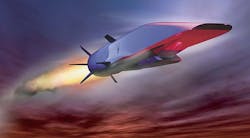Orbital ATK to help U.S. military develop hypersonic propulsion for aircraft and missiles
ARLINGTON, Va. – Aviation propulsion experts at Orbital ATK Inc. in Elkton, Md., are helping U.S. government researchers develop a full-scale reusable propulsion system for future hypersonic aircraft and missiles that can fly at least five times the speed of sound.
Officials of the U.S. Defense Advanced Research Projects Agency (DARPA) in Arlington, Va., announced a $21.4 million contract to ATK on Tuesday for the Advanced Full Range Engine (AFRE) program.
This project seeks to develop and ground-demonstrate a full-scale, reusable turbine-based combined-cycle (TBCC) propulsion system for future hypersonic aircraft. TBCC combines a turbine engine for low-speed operations with a ramjet/scramjet for high-speed operations via a common inlet and nozzle.
Reliable hypersonic propulsion technology will be necessary for future generations of high-speed manned and unmanned military aircraft, as well as for next-generation anti-ship missiles and other smart munitions, DARPA officials say. Hypersonic propulsions may enable military aircraft and missiles to fly from long ranges with short response times compared to current military systems.
Related: Hypersonic flight is coming: will the U.S. lead the way?
Developing hypersonic aircraft and missile propulsion confronts engineers with two difficult challenges, DARPA researchers say. First, the top speed of traditional jet-turbine engines maxes out at roughly Mach 2.5. Second, hypersonic engines such as scramjets cannot provide effective thrust at speeds much below Mach 3.5.
An air-breathing hypersonic vehicle developed today would use disposable rockets for one-time boosts up to operating speed, which limits the vehicles's usefulness, experts say.
The DARPA AFRE program seeks to combine the best available commercially available technologies in jet turbine engines and ramjet/scramjet technologies.
“Instead of designing an entirely new kind of engine, we’re envisioning an inventive hybrid system that would combine and improve upon the best of off-the-shelf turbine and ramjet/scramjet technologies,” says Christopher Clay, the DARPA AFRE program manager.
Related: Air Force asking industry for enabling technologies for future hypersonic munition
"With recent advances in manufacturing methods, modeling, and other disciplines, we believe this potentially ground-breaking achievement may finally be within reach.”
Orbital ATK experts will address technologies to enable the turbine engine and ramjet/scramjet to switch from the low speed to high speed, common inlet and nozzle. Later, company experts may conduct an integrated freejet test of a TBCC propulsion system from takeoff to hypersonic flight.
The first phase of the AFRE program calls for Orbital ATK to conduct system design, subscale and large-scale component development, and ground demonstration. If results of the first phase are promising, Orbital ATK may conduct a large-scale test of the integrated low-speed and high-speed flowpaths.
For more information contact Orbital ATK online at www.orbitalatk.com, or DARPA at www.darpa.mil.
Learn more: search the Aerospace & Defense Buyer's Guide for companies, new products, press releases, and videos

